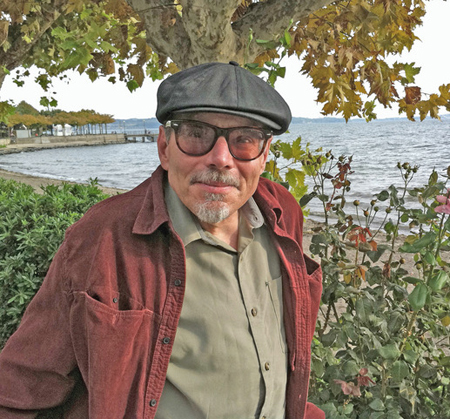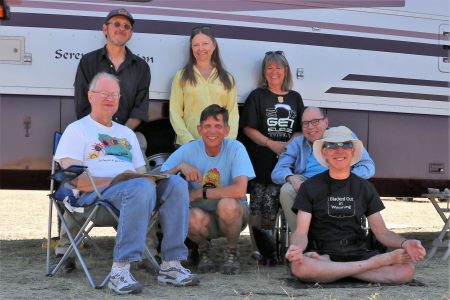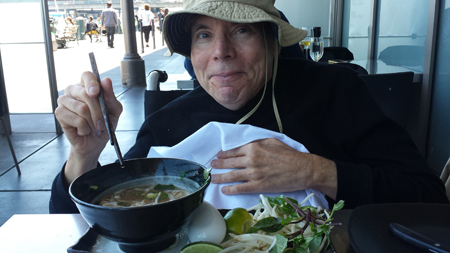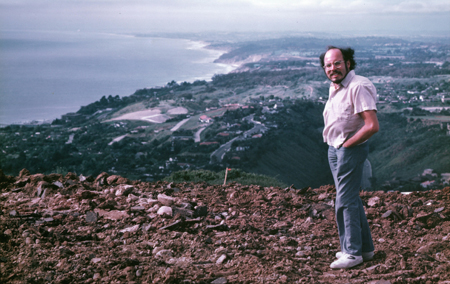18 September 2023–A new fund at SSA honors the life and accomplishments of Paul Andrew Spudich (1950-2019) by supporting the professional development of Society members at the beginning of their careers in seismology.
Through The Paul Andrew Spudich Fund, SSA will establish the Paul Andrew Spudich Travel Grant program, which will begin by issuing one travel grant of up to $3,500 in March 2024 to support student or early-career members with a research focus in earthquake source physics or ground motion prediction, areas Spudich made important contributions to during his distinguished career as a seismologist with the U.S. Geological Survey (USGS). The application period will open in February.
Additional donations are invited to the fund so that it can grow and enable SSA to provide an increasing number of annual grants in the future. To lend your support to a great cause in honor of a great seismologist, visit The Paul Andrew Spudich Fund Web page.
Remembering Paul Andrew Spudich (1950-2019)
A pioneering scientist
Paul Andrew Spudich’s life story is certainly interesting and could be considered inspirational. Humble beginnings living in “the projects.” A Croatian immigrant father, Andrew, who labored for 40 years at U.S. Steel’s Duquesne Works, and mother, Annie, who tended to the family and worked as a secretary. A polio diagnosis in 1952 led to hospitalizations, surgeries and yearlong bed confinement. But nothing ever stopped him from living a life full of family, friends, travel and hilarity while doing the work he was clearly called to do.
Spudich earned his undergraduate degree at Carnegie Mellon University then studied at Woods Hole Oceanographic Institution. From there he moved on to the Scripps Institute of Oceanography, University of California, San Diego, and finally the U.S. Geological Survey (USGS), Menlo Park, where, during his 35-year career, he became a world leader in understanding the physics of earthquake sources and resolving earthquake rupture processes from waveform modeling. And somehow, he found time to spend a year at film school and take a yearlong solo trip around the world.

Ralph Archuleta, distinguished professor emeritus of earth sciences at the University of California, Santa Barbara, attended grad school with Spudich and counted him as one of his closest friends. He teamed with USGS seismologist Jon Fletcher to write a tribute to Spudich in Seismological Research Letters that noted his “strong commitment to using analysis to assist in efforts to reduce the consequences of earthquakes.”
In the months before his death, Spudich shared his own thoughts for the piece, pointing to two of his papers as the ones he felt had made the most scientific impact: “the 1980 articles that defined the structure of the oceanic crust (Spudich and Orcutt, 1980a,b) … the results are so accepted as the description of the oceanic crust that they rarely get cited anymore.”
Plate tectonic theory was only about a decade old at that time, Archuleta points out. “We had ideas about the crust, knew there were three layers, but what is its structure? These were important papers to the larger geophysical community,” he says, explaining how many scientists in fields beyond seismology benefited from Spudich’s insights.
National Academy of Sciences President Marcia McNutt, another Scripps alum who knew Spudich well, admired him greatly as a scientist and a former USGS colleague. “Paul was a generous collaborator on many projects,” McNutt says, and although she didn’t co-author any studies with Spudich, she points to the significant insights he contributed to strong ground motion studies that not only helped researchers better characterize the physical properties of faults, but also had practical implications for helping engineers design for earthquake safety.
Some of Spudich’s other notable contributions in the field, she says, confirmed the importance of fault directivity and the signature of waves trapped within fault zones. She also points to his work with co-authors developing and applying Green’s functions to simulate strong ground motion for large earthquakes, using the math from better constrained smaller earthquakes.
“His work directly improved public safety in earthquake-prone areas,” McNutt says. “He shared the software tools he developed widely.”
The broad impact of his fieldwork and theoretical studies led to Spudich’s election as Fellow of the American Geophysical Union and earned him the Department of Interior’s Meritorious Service Award as well as its Distinguished Service Award, the department’s highest honor.
Wild and witty

Throughout his life, Spudich sought out adventure, say those who knew him well. He was ready to explore any country, cuisine or creative endeavor.
Spudich was “a particularly charming and entertaining colleague,” McNutt says, recalling that “his favorite movie was ‘Attack of the Killer Tomatoes’ in which he had a bit part in a crowd scene at the stadium in San Diego, dressed as a pyramid. He was always the life of the party on account of his dry sense of humor.”
A few examples? Greg Beroza, Wayne Loel Professor of Earth Sciences at Stanford University, completed most of his thesis under Spudich’s guidance. “When visiting him as a grad student, I watered the houseplant he had in his office,” he recalls. “Apparently, this level of care was unusual, as afterwards I received a postcard from ‘Spudich’s Plant’ desperately asking me to come back and water it.”
Others remember Spudich’s 4-WD Subaru with the Yes on No bumper sticker on one end, No on Yes on the other parked outside his office at the USGS where employee displays of politics are prohibited. And visitors to one of Spudich’s past residences had some laughs when they saw the scientist had carefully labelled the exposed plumbing pipes as anti-protons, protons, electrons or positrons.
Spudich even injected some wit into the 2001 SSA Annual Meeting Report, describing the gathering in San Francisco as “the Society’s largest ever Annual Meeting (we think, given our incomplete records and some wishful extrapolation).” He noted that “the Bhuj, India and Nisqually, Washington earthquakes failed to comply with the meeting abstract deadline, so special sessions on both earthquakes were added to the meeting schedule.” And he gave a quick shout-out to the “few intrepid SSA members” who “heroically pried themselves out of their sacks” to make the 1906 earthquake commemorative event that began at 5:12 AM.

Chairing that meeting was one of many ways that Spudich, a longtime member and donor, served the SSA community. He was one of the first contributors to the Joyner Fund that continues to support the important Joyner Lecture series today. A member of SSA’s Board of Directors and Honors Committee, he worked to give members a greater voice in the Society’s annual awards program. “He thought nominations should come from the broader community beyond the Board,” says Archuleta. “He wanted it to be more fair.”
SSA President Ruth Harris remembers these contributions well. “He devoted great care and thought to his visionary ground-breaking science and to his volunteer service to our community,” she says. “He wrote the detailed version of the guidelines for the SSA awards. He put a lot of time and thought into that effort, as he did with everything he tackled, both for SSA and for his other activities. He was very conscientious and thoughtful in all that he did, and we all benefited from his efforts.”
Spudich’s prose is remembered as being as flawless as his science. Former colleagues mention the great care and thought he put into every project and paper.
“Paul was a thinker. When he had a question, he thoroughly explored to get the answer,” says his USGS colleague Larry Baker, who recalls a pre-GPS time when Spudich pumped out page after page of calculations to ensure the precise spacing and orientation of an instrument array to establish synchronicity at 14 different locations.
His mentee Beroza remembers Spudich’s wild ideas like turning Half Dome into a seismological reflecting telescope. “When talking with him about them, he would refer to his lab notebooks, which were full of equations and diagrams exploring those same ideas,” Beroza says. “He put a lot of thought into them.”
Spudich wasn’t afraid to explore uncharted territory, whether it was an off-road adventure through the desert or the world of seismology. “He had a rebellious streak,” Beroza says, pointing to the example of “his paper on the determination of absolute stress levels from seismic radiation, which was superficially thought to be impossible.”
High ethics
Spudich may have pushed at the boundaries of knowledge but seismologists remember him as a stickler for the rules, so conscientious and careful in the way he conducted himself and treated others. Peggy Hellweg, SSA past president, spent five years working at the USGS with Spudich as her supervisor. She was part of his group running the Parkfield Dense Array to observe the rupture of the Parkfield earthquake. She also worked with him on his study to characterize possible shaking at the proposed site for storing nuclear waste at Yucca Mountain, Nevada.

“I always felt valued when working with Paul, and appreciated his ability to mentor me while including my ideas in progress on the projects,” she says, recalling how he also encouraged her to attend and present their results at meetings. “Paul’s high research ethics also impressed me.”
Friends say Spudich wouldn’t dream of accepting even a cup of coffee on government-funded travel lest it be construed as a gift. He returned from work trips with his suitcase filled with receipts that he carefully itemized. Many of the receipts were for the buses and taxis he took as the effects of polio, which curved his spine, diminished his lung capacity and weakened one leg, increasingly affected his mobility.
“He never complained,” says Archuleta. “Never used it as an excuse.” Spudich was a realist, Archuleta says. He knew he was on borrowed time and chose to make the most of it. The scientist explored so many creative pursuits, from cooking to the conga drums, and made an annual trip to Burning Man as long as his health allowed.
Just a few weeks before his death, Spudich’s colleagues in Italy were presenting their collaborative work, spearheaded by Spudich, on quantifying uncertainty in inversions due to imperfect knowledge of crustal velocity structure. That work will continue while countless more collaborations and connections await the scientists who will travel with grants in Spudich’s memory.
The impressive body of scientific work he left behind might never have existed considering the year Spudich took off between his master’s and Ph.D. to study filmmaking at the California College of the Arts. Archuleta recalls how Spudich ultimately decided he had a greater chance of success in the world of seismology. That decision may have been a loss to the movie industry but, says Archuleta speaking for his colleagues in the scientific one, “We’re all lucky he stayed.”
DONATE TO THE PAUL ANDREW SPUDICH FUND